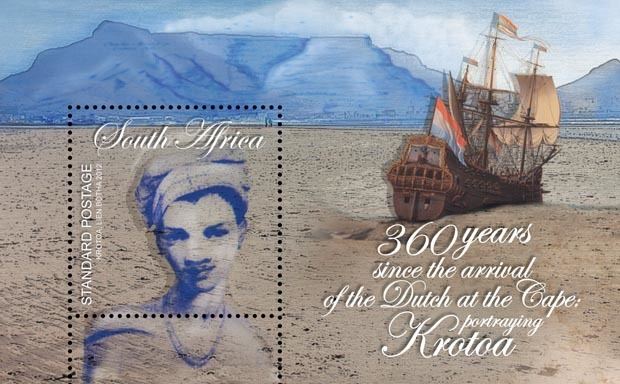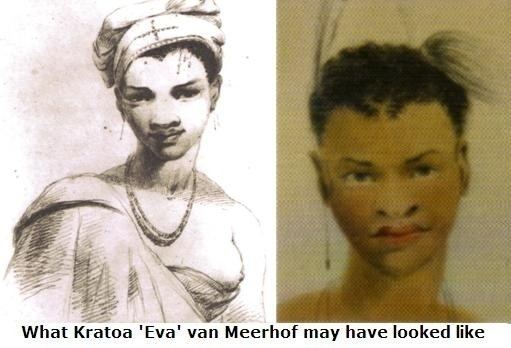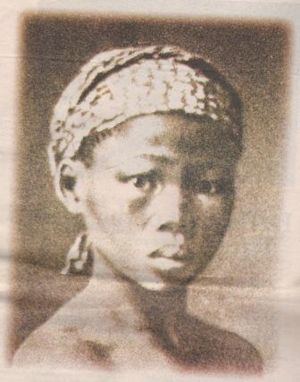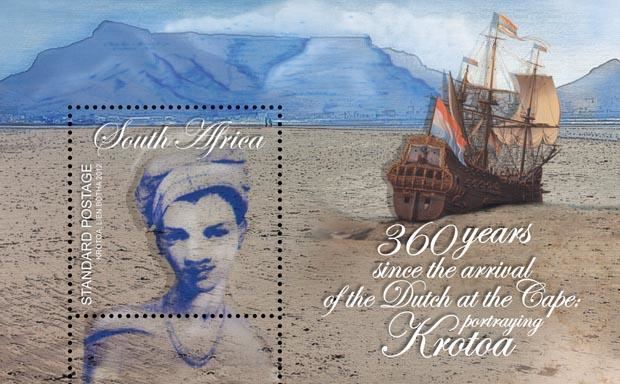Name Eva Meerhof Native name Krotoa Other names Eva van Meerhof | Ethnicity Goringhaicona Spouse(s) Pieter van Meerhof | |
 | ||
Died July 29, 1674, Robben Island, Cape Town, South Africa Similar Autshumato , Jan van Riebeeck, Khoikhoi | ||
Krotoa trailer
Krotoa, or Eva (c. 1643 – 29 July 1674), was a Khoi woman who served as a translator for the Dutch during the founding of the Cape Colony. She is noted as one of the most written about women in South African history, with her name appearing in the journals of the Dutch East India company from as early as 1652.
Contents

krotoa official trailer hd
Biography

Krotoa was born in 1643 as a member of the Goringhaicona (Strandlopers) tribe, and the niece of Autshumao, a Khoi leader and trader. At the age of 12 she would be taken in to work in the household of Jan van Riebeeck, the first governor of the Cape colony. As a teenager, she learned Dutch and Portuguese and like her uncle, worked as an interpreter for the Dutch who wanted to trade goods for cattle. Unlike her uncle however, Krotoa was able to obtain a higher position within Dutch hierarchy as she additionally served as a trading agent, ambassador for a high ranking chief and peace negotiator in time of war. Her story exemplifies the initial dependency of the Dutch newcomers on the natives who were able to provide reasonably reliable information about the local inhabitants. She was later married to a Dutch settler called Pieter Van Meerhof. She and Meerhof would have three children.

The Dutch’s initial arrival in April 1652 was not unilaterally viewed as negative. Many Khoe people saw the Dutch’s arrival as an opportunity for personal gain as middle men in the livestock trade; others saw them as potential allies against preexisting enemies. At the peak of Krotoa’s career as an interpreter, she held the belief that the Dutch presence could reap benefits on both sides.
There are multiple accounts of how Krotoa came to work under the household of Jan Van Riebeeck. One account paints the story of how the Dutch forcefully kidnapped the child Krotoa, however no hard evidence confirms this account. Krotoa was taken in as a companion and as a servant to Riebeeck's wife and children. However, many authors and historians speculate that she most likely lived in an incestuous space, based on the fondness Van Riebeek presented towards her in his journals. Circumstantial evidences supports the theory that at the time of the Dutch arrival, Krotoa lived with her uncle Autshumato (also known as Harry by the Dutch). The circumstantial evidence being that Krotoa showed consistent hostility to the Goringhaiqua clan and by associated to her own mother, who lived with them. In contrast Krotoa’s fate and fortunes were closely aligned to those of her uncle Autshumato and to his clan known as the Goringhaicona. The Goringhaicona people who were sedentary, non-pastoral hunter-gathers are believed to be one of the first clans to make acquaintances with the Dutch people. Prior to the Dutch’s arrival Autshumato served as a postal agent for passing ships of a number of countries. If the theory of Krotoa having lived with her uncle is true, then Krotoa’s early service to the Dutch may not have been as violent a transition as it was made out to be.

It is believed that the birth of the first baby of chaplain/sick-healer Willem Barentssen Wijlant, and his wife coupled with the rapid spreading of a virulent disease in the settlement sparked the initial negotiations to obtain services from a local girl. As Autshumato had a long history of working for Europeans, it is believed that the Dutch first turned to Autshumato for negotiations. It is quite possible that Autshumato offered up his niece for servitude in order to better his standings with the Dutch.

On 3 May 1662 she was baptised by a visiting parson, minister Petrus Sibelius, in the church inside the Fort de Goede Hoop. The witnesses were Roelof de Man and Pieter van der Stael. On 26 April 1664 she married a Danish surgeon by the name of Peter Havgard, whom the Dutch called Pieter van Meerhof. She was thereafter known as Eva van Meerhof. (See Geni/MyHeritage) She was the first Khoikoi to marry according to Christian customs. There was a little party in the house of Zacharias Wagenaer. In May 1665, they left the Cape and went to Robben Island, where van Meerhof was appointed superintendent. The family briefly returned to the mainland in 1666 after the birth of Krotoa’s third child, in order to baptize the baby. Van Meerhoff was murdered on Madagascar on 27 February 1668 on an expedition. After the death of her husband Pieter Van Meerhoff, came the appointment of a new governor Zacharias Wagenaer. Unlike the governor before him he held extremely negative views toward the Khoe people and because at this point the Dutch settlement was secure, he didn’t find a need for Krotoa as a translator anymore.

Krotoa returned to the mainland on 30 September 1668 with her children. Suffering from alcoholism, she left the Castle in the settlement to be with her family in the kraals. In February 1669 she was imprisoned unjustly for immoral behavior at the Castle and then banished to Robben Island. One of Van Riebeeck’s nieces, Elizabeth Van Opdorp, adopted Krotoa's children after she was banished. She returned to the mainland on many occasions just to find herself once more banished to Robben Island. In May 1673 she was allowed to baptise a child on the mainland. Three of her children survived infancy. She died on 29 July 1674 in the Cape and was buried on 30 September 1674 in the church in the Fort.

Pieternella and Salamon, Krotoa’s two youngest children from her marriage to van Meerhof, were taken to Mauritius in 1677. Pieternella, who was known as Pieternella Meerhof or Pieternella van die Kaap, later married Daniel Zaaijman, a VOC vegetable farmer from Vlissingen. They had four sons and four daughters, one of whom was named Eva, and the family moved back to the Cape in 1706. Their granddaughter, Engela Catharina Zaaijman married Abraham Peltzer, son of Abraham Peltzer, a VOC soldier from Hamburg, Germany and Elizabeth van den Berg.
